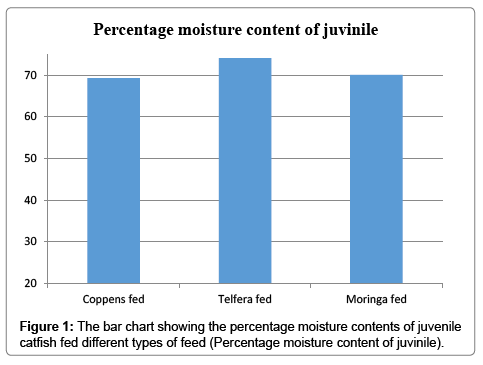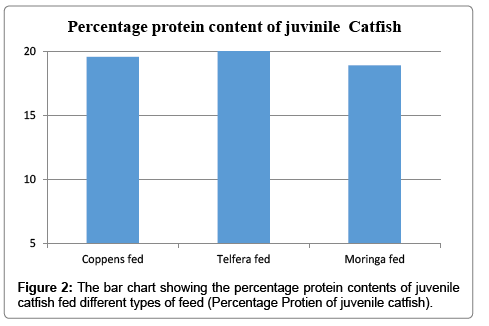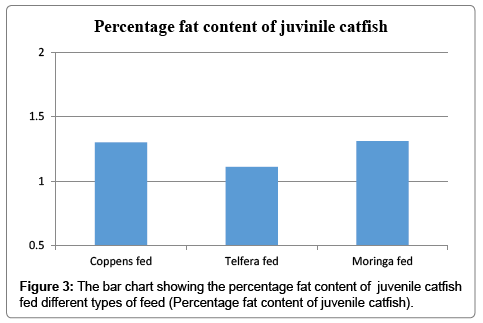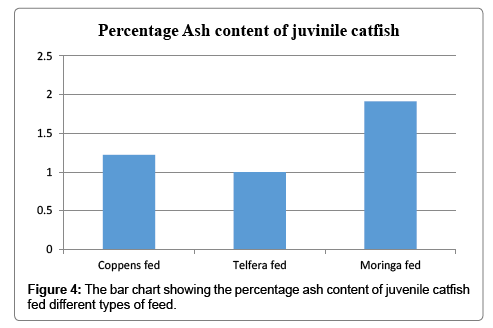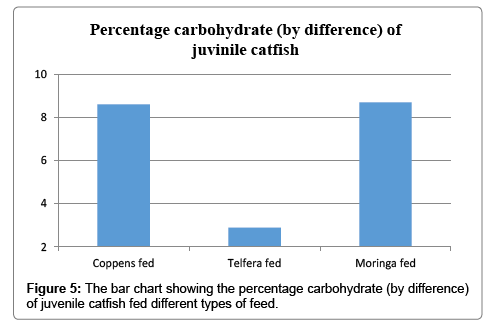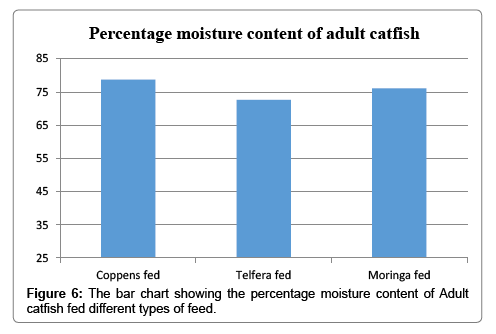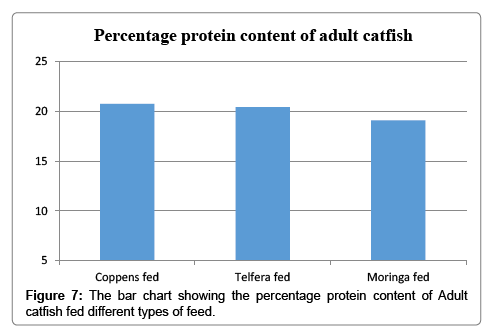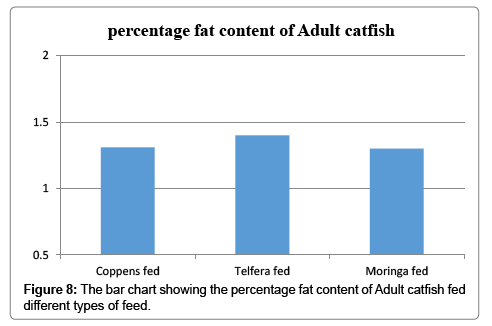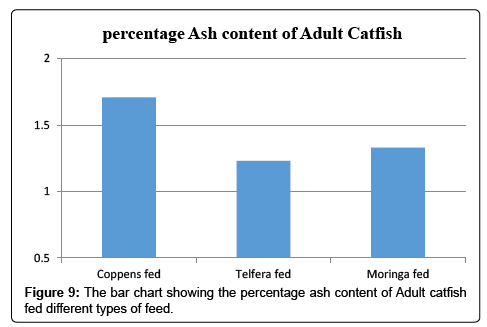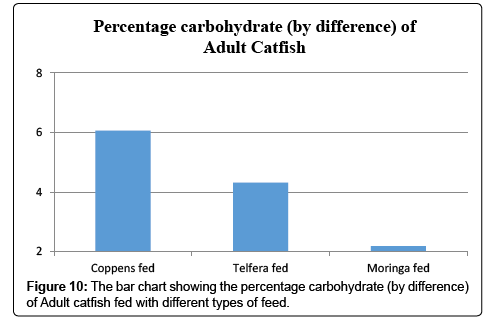Proximate Analysis and Nutritional Value of African Catfish (Clarias gariepinus) Fed with Local (Telferia occidentales and Moringa olefera) and Industrial Feed (Coppens)
Received: 20-Mar-2018 / Accepted Date: 16-Apr-2018 / Published Date: 18-Apr-2018 DOI: 10.4172/2332-2608.1000267
Abstract
Work on Proximate Analysis and Nutritional Value of catfish fed with Local and Industrial feed was carried out from July-September, 2017. The fish were fed from Juveniles to Adulthood with various feed types. The Proximate Analysis results and the nutritional value shows that Juveniles fed with Telferia occidentales composition has the highest moisture content 74.08% those fed with Coppens has the lowest moisture content 69.32%. While in Adult Catfish, those fed with Coppens had the highest moisture content 78.70% and those fed with Telferia occidentales composition had the lowest 72.63%. The protein content in Juveniles fed with Telferia occidentales composition 20.00% and these fed with Moringa olefera had the lowest protein content of 18.88%, also protein content in adult fed Coppens has the highest protein content 20.75% and those fed with Moringa olefera composition had the lowest protein content 19.09%. The Carbohydrate content in Juveniles is highest in those fed with Moringa olefera composition 8.71% and those fed with Telferia occidentales composition has the lowest carbohydrate content 2.90%. While in adult catfish, those fed with Coppens had the highest content 6.07% and those fed with Moringa Olefera has the lowest carbohydrate content 2.18%. The Mean Oil content in Juveniles fed with Moringa olefera composition is highest 1.31% compared to others fed with Coppens, 1.30% and Telfera occidnetales composition, 1.11%. The Mean Oil content in adult is highest in those fed with Moringa olefera 1.40% and lowest in those fed with Telfera occidentales composition, 1.30%. The Ash Content in Juveniles fed with Moringa olefera was high 1.91% and low in those fed with Telfera occidentales composition 1.00%, adults fed with Moringa olefera composition is high 1.33% and low in those fed with Coppens 1.17%.
Keywords: Telferia occidentales; Nutritious; Feed materials; Aquaculture
Introduction
Fish is widely acceptable because of its high palatability, low cholesterol, tender flesh, cheap and its aroma in cooking [1]. Fish is known to be one of the cheapest sources of animal protein and have essential nutrients needed in human diets [2]. Fish and fish products are highly nutritious with protein content of 15-20% and are particularly efficient in supplementing the cereal and tuber diets widely consumed in Africa [3].
In Nigeria, fish is a major food item contributing a total of 40% dietary protein requirements and a readily available source of animal protein in the diet of man [4]. Fish is highly nutritious with balanced amino-acids, minerals and vitamins for healthy human growth. It is less tough and more digestible when compared with chicken, beef and mutton [3].
The African catfish, Clarias gariepinus is one of the most widely consumed freshwater fish in Nigeria due to its large acceptability [1]. Nutritional composition of cultivated fish is majorly dependent on the type of food administered. Other factors may include feeding habit, water quality, cultured medium and period [3]. To produce lean fish with less fat deposition, feed materials, are to be carefully selected and administered. Visual assessment of fish using size, freshness, and other physical appearances may not give accurate nutritional information about the fish, hence the need for laboratory analysis of fish for indepth information on the nutritional quality [5].
Fish is an important source of both food and income to many people in developing countries. In Africa as much as 5% of the population, some 35 million people demands wholly or partly on the fisheries sector for their livelihood [6]. It is estimated that 2050, when world population is projected to be over 9 billion, Africa will have to increase food production by 300%, Latin America by 80% and Asia 70% to provide minimally adequate diets for the projected population of 2 billion, 810 million and 5.4 billion people in the respective region [7]. The consumption and demand for fish as a cheap source of protein is on the increase in Africa, because of the level of poverty in the land. There is a considerable potential to expand fish aquaculture in Africa in order to improve food security [8]. One of the major hindrances to the development of fish aquaculture industry in Africa is the lack of locally produced high-quality fish feed. Therefore local production of fish feed is very crucial to the development and sustainability of fish aquaculture in Africa especially in the rural areas. For fish aquaculture to thrive and bridge the already existing wide gap between fish demand and supply especially in the sub-Saharan Africa, the vital role of locally produced fish feed in reducing product cost, thereby making fish farming attractive to both private and commercial investors and ultimately boost fish production cannot be overemphasized.
The major constituents of fish are; water, protein, lipid and carbohydrates [9]. It has both reported that, proximate composition of fish varies greatly and the variation could be due to age, feed intake, sex and sexual changes connected with spawning, the environment and season [10]. Proximate composition has been reported to be a good pointer of physiology need for routine analysis of fisheries [11].
The knowledge of fish composition is essential for its maximum utilization. The African catfish (Clarias gariepinus) belongs to the family Claridae (air-breathing catfishes), Order Siluriformes (catfish), class Actionopterygii (ray –finned fishes), Sub-phylum vertebrate, Phylum Chordata and Kingdom Animalia. The family Claridae is divided into two genera viz: Clarias and Heterobranchus. There are over hundred species in this family occurring naturally throughout most of Africa and the Southern half of Asia to Java and the Philippines [12].
C. gariepinus is generally considered to be one of the most important tropical catfish species for aquaculture. It has an almost Pan-African distribution, ranging from the Nile to West Africa and from Algeria to Southern Africa. They also occur in Asia Minor, Israel, Syria and South of Turkey. C. gariepinus is characterized with naked skin and with fairly long dorsal and anal fins. They have string pectoral fins with spines that are serrated on the outer side [13]. It possesses nasal and maxillary barbells and smallish eyes. Their coloring is dark grey or black dorsally and cream coloured ventrally. Adults possess a dark longitudinal line on either side of the head; however, this is absent in young fish. Adult’s heads are coarsely granulated, while the head is smooth in the young. The head is large, depressed and heavily boned. The mouth is quite large and sub-terminal [14]. In C. gariepinus, exchange of respiratory gases (i.e., oxygen and carbon dioxide) takes place through the gills. Catfish of the world are represented by at least 2,000 species in over 25 families [13]. In Nigeria, reported seven families, sixteen genera and fifty one species of catfishes, and noted that most of them live in freshwater and very few are marines.
Fish of various species don’t provide the same nutrient profile to their consumer and the nutritive value of a fish varies with season [15,16].
Moisture, dry matter, protein, lipids, vitamins and minerals are the most important components that act as sources of nutritive value of fish meal [17].
Quantifying proximate composition is important in ensuring the requirements of food regulations and commercial specification [18]. Moisture content of flesh is a good indicator of its relative content of energy, protein and lipid [19]. Fish meat contains significantly low lipids and higher water than beef or chicken and is favored over other white or red meals [20]. The total lipid and ash content of fish vary with the increasing weight or length of the fish, it may also vary with the season and varied habitats and feed [21].
Among the proximate composition, protein in fish is the excellent source, because of the amino acid composition and degree of digestibility [22].
Several studies on proximate composition of fish have been from different parts of the world so far. Nutritional analysis of some freshwater fish was determined by from Naramala, Ibbagamuva and Nikaveratiya in Sri Lanka [23]. Proximate composition of different freshwater fish’s especially African catfish (Clarias gariepinus) was estimated by Kamel et al. [24].
The range of moisture, protein, fat and ash content of some Nigerian smoked catfish species were reported as follows; 7.16-10.17%, 33.66- 66.04%, 1.58-6.09% and 9.12-12.16%, respectively [4].
Okonji and Akhirevbulu [25] explain fatty acid composition in two vital fish species Clarias gariepinus and Oreochromis niloticus cultured in semi-intensive fish tank.
Osibon et al. [26] mentioned that the proximate and fatty acids composition of African catfish Clarias gariepinus from Lekki Lagoon fish ground in Lagos, South Western Nigeria with a view to provide nutritional data for dietary planning.
Mohanty et al. [27] reported that proximate analysis, amino acids composition, fatty acid profile and elemental composition of Giant River Catfish Sperata seenghala with the perspective to give the healthful profile.
Taiwo [28] determined the proximate chemical composition and lipid profile of muscles of the cultures and wild African Catfish, Clarias gariepinus from Nigerian waters.
Sesugh et al. [29] validated the correlation of proximate chemical composition of flesh of important commercial fishes Scomber scumbrus, Trachertus trachurus, Micropogonias funieri, Sardinella aurita and Clarias gariepinus from Nigeria.
Ayoloja [30] analyses the nutritional comparison of two freshwater fishes Clarias gariepinus and Oreochromis niloticus.
Joseph [31] evaluated that protein and lipid levels in connection to the season and feeding in Catfish Arius arius from Cochin backwater.
Adewumi [12] examined the food and feeding habitats of African sharp tooth catfish Clarias gariepinus obtained from Ogbese River and those cultured in Ore-Ofe fish farm was carried out along with the chemical characteristics of fillets.
Materials and Methods
Collection of fish specimens
Sixty healthy juveniles of African Catfish, Clarias gariepinus were purchased from Bush Farm in Gwagwalada Local Government Area of the Federal Capital Territory Abuja. The fishes were transported in an open 10 L container to Biological Sciences Laboratory of the University of Abuja in clean freshwater.
Laboratory procedure
The fishes were acclimatized for 14 days. After 14 days waters of acclimatization, the average body weight of 20 Juveniles of C. gariepinus was measured and transferred into each of the plastic experimental tanks using a scoop net. Suitable conditions were maintained by clearing the tanks and constantan changing of the water which took place every three days.
Feed source
For industrial (already made) Feed, the fish feed was purchased from Mallam Sani Ventures, at Mallam Sani Shopping Complex along Kuje road, opposite Timber Shade, Gwagwalada Area Council, Abuja.
For local made food (Moringa olifera incorporated)
The Moringa leaves powder was incorporated into the compound feed mixed with pap, pelleted and dried. The feed was pelleted into 2 mm pellet size to enable the fish swallow them easily.
For local made feed (Telfera occidentales incorporated)
The Telfera occidentales (Ugu leaves) powder were incorporated into the compound feed mixed with pap, pelleted and dried. The feed was pelleted into 2 mm pellet size to enable the fish swallow them easily.
Experimental set-up
6 plastic tanks (75 × 95×70 cm) were used for the experiment. Each of the tank was cleared by washing the tanks properly with soap and water after which the tank were filled with water for three to four days to remove the residue of the soap used in washing. The water was removed after four days. Each of the tanks was filed with decolorized tap water and was stocked with 10 Juveniles of C. gariepinus. The water was filled to 2/3 of the volume of each tank (50 liters). The tank was labeled T0, T1, and T2 each having duplicates. The tanks labeled represent each of the feeding regimes. Tables 1 and 2 show the percentage composition of the experimental feed. Moringa olifera at 6.46 kg, Telferia occidentales 6.11 kg.
| Ingredients | Crude Protein | Percentage inclusion level in 100kg |
|---|---|---|
| Moringa olifera | 30.3 | 25.84 |
| Rice bran | 10 | 22.48 |
| Beans (Cowpea) | 22 | 25.84 |
| Fishmeal | 48 | 25.84 |
Table 1: Percentage composition of experimental feed I.
| Ingredients | Crude Protein | Percentage inclusion level in 100kg |
|---|---|---|
| Beans (Cowpea) | 22 | 24.44 |
| Rice bran | 10 | 26.67 |
| Telfera occidentales | 23 | 24.44 |
| Fishmeal | 48 | 24.44 |
Table 2: Percentage composition of experimental feed II.
Feeding fish
The fishes were fed 2 times a day in equal proportions with their various experimental feeds for a period of 12 weeks.
Proximate analysis
It involves an assay for all the constituents a sample apart from the major food constituents. Each fish sample was taken to the laboratory, sacrificed and homogenized. Samples for the different analyses were then taken from the homogenized material. Triplicate determinations were carried out on each group.
Determination of moisture
The moisture content of each fish samples was determined using the over drying method following the method of AOAC [32].
Determination of ash
Ash content of fish samples was determined by incineration in a carbolated Sheffield LMFs Muffle Furnace at 500°C [32].
Determination of lipid
The percentage lipid content in the muscles was determined using the Soxhlet extraction method.
Determination of protein
The total nitrogen (crude protein) was determined using the Kjeldahl method.
Determination of carbohydrate
The carbohydrate content was calculated by difference %NCHO=100–(Sum of the percentage of moisture, ash, lipid, protein).
Statistical analysis
Descriptive Statistic Means were used in presenting the data, while ANOVA was used to test for significant differences.
Results
The results of proximate analysis of catfish (Clarias gariepinus) Juvenile fed with Telfera occidentales composition, Moringa olifera composition and Coppens as control is presented in Table 3 below.
| Parameters | Coppens fed catfish | Telferaoccidentales fed catfish | Moringaolifera fed catfish |
|---|---|---|---|
| Moisture | |||
| Content % | 69.32 | 74.08 | 70.1 |
| Protein % | 19.54 | 20 | 18.88 |
| Fat % | 1.3 | 1.11 | 1.31 |
| Ash % | 1.22 | 1 | 1.91 |
| Carbohydrate (by difference %) | 8.62 | 2.9 | 0.71 |
Table 3: Proximateanalysis of catfish juvenile fed with telferaoccidentales composition, moringaolifera composition and coppens.
Discussion
Figure 1 shows that Juvenile Catfish fed with Telfera has the highest moisture content followed by Juvenile Catfish fed with Moringa and Juvenile catfish fed with Coppens has the lowest composition. Figure 2 shows that Juvenile Catfish fed with Moringa has the lowest protein content followed by Juvenile Catfish fed with Coppens and Juvenile catfish fed with Telfera occidentals has the highest composition. Figure 3 shows that Juvenile Catfish fed with Moringa has the highest fat content followed by Juvenile Catfish fed with Coppens and the Juvenile Catfish fed with Telfera occidentales has the lowest fat composition. Figures 4 and 5 shows that Juvenile Catfish fed with Telfera occidentales has the lowest ash content followed by Juvenile catfish fed with Coppens and Juvenile catfish fed with Moringa has the highest carbohydrate content followed by Juvenile catfish fed with Coppens and juvenile catfish food with Telfera occidentales has the lowest carbohydrate composition. Figure 6 shows that adult catfish fed with Coppens has the highest fed with Moringa and adult catfish fed with Telfera occidentales has the lowest moisture composition. Figure 7 shows that adult catfish fed with Moringa has the lowest protein content followed by adult catfish fed with Telfera occidentales and adult catfish fed with Coppens has the highest protein composition. Figure 8 shows that adult catfish fed with Telfera occidentales has the highest fat content followed by adult catfish fed with Coppens has the lowest fat composition. Figure 9 shows that adult catfish fed with Moringa has the highest ash content followed by adult catfish fed with Telfera occidentales and adult catfish fed with Coppens has the lowest ash composition. Figure 10 shows that adult catfish fed with Moringa has the lowest carbohydrate content followed by adult catfish fed with Telfera occidentales and adult catfish fed with Coppens has the highest carbohydrate composition. From Table 3 Juvenile catfish fed with Telfera occidentales has the highest percentage of moisture, 74.08% while juvenile catfish fed with Coppens has the lowest moisture content, 69.32%. Then the protein level in juvenile catfish fed with Coppens is 19.54% and 20.00% juvenile fed with Telfera occidentales, in juvenile catfish fed with Moringa is 18.88% since the level of protein is high in juvenile catfish fed with Telfera occidentales, it is advisable for commercial fish farmers to incorporate Telfera occidentales in the fish feed composition. Juvenile catfish fed with Coppens 1.30%, 1.11% in Telfera occidentales fed catfish and 1.31% in Moringa fed catfish, fat is important in the body because it helps in forming structural materials of cells and tissues such as the cell membrane. The carbohydrate present in Moringa fed catfish is 8.71% in Coppens fed catfish is 8.62% and 2.90% in Telfera occidentales fed catfish, carbohydrate which helps in complete breaking down of other nutrients in the body. From Table 4 Adult catfish fed with Coppens has the highest percentage of moisture, 78.70% while adult fed with Telfera occidentales has the lowest moisture content 72.63%. Then the protein level in adult fed with Coppens is 20.75% and 20.42% in adult fed with Telfera occidentales, in adult fed with Moringa is 19.09%. Since the level of protein is high in adults fed with Coppens, it is of great advantage for fish farmers to feed their catfish with Coppens feed. Adults fed with Coppens 6.07%, 4.32% in Telfera occidentales fed adult and 2.18% in Moringa fed adult, it shows that the carbohydrate level in adult catfish fed with Coppens is higher that these fed with Telfera occidentales and Moringa composition. Adult catfish fed with Coppens is 1.31%, 1.40% in adult fed with Telfera occidentales and 1.30% in adult fed with Moringa, which tells us that catfish fed Telfera occidentales composition has more body fat composition.
| Parameters | Coppens fed catfish | Telferaoccidentales fed catfish | Moringaolifera fed catfish |
|---|---|---|---|
| Moisture Content % | 78.7 | 72.63 | 76.1 |
| Protein % | 20.75 | 20.42 | 19.09 |
| Fat % | 1.31 | 1.4 | 1.3 |
| Ash % | 1.17 | 1.23 | 1.33 |
| Carbohydrate (by difference %) | 6.07 | 4.32 | 2.18 |
Table 4: Proximate analysis of catfish adult fed with telferaoccidentales composition, moringaolifera composition and coppens.
Summary, Conclusion and Recommendation
Summary
Moisture of a given sample simply refers to the water content of that sample. Results obtained from the proximate analysis of the various stages of catfish growth showed that the fish samples, juvenile fed with Telfera occidentales has the highest percentage of moisture, 74.08% while juvenile fed with Coppens has the lowest moisture content, 69.32%. The catfish had moisture ranging from 69.32% to 74.08% indicating that the percentage moisture in fish muscles was within the acceptable level (60-80%) in all the samples. The percentage of water is also a good indicator of its relative content of energy, protein and lipid. There was a significant difference (P=0.00) between the three fish samples. The results in Table 4 shows that all adult catfish are good sources of protein with adult fed with Coppens having the highest protein content (20.75%) and adult fed with Moringa having the lowest protein content of (19.09%). Te protein content of adult samples ranged from 19.09% to 20.75%. There was a significant difference (P=0.006) between the values. The differences observed in values obtained could be as a result of the fish consumption or absorption capability and conversion potentials of essentials nutrients from their diets [33,34].
Lipids are generally soluble in either hence, they are other extractable. They serve as source of energy driving starvation and fasting. The mean oil content (1.11%) of juvenile catfish was relatively low compared to the oil content of other juveniles fed with Coppens and Moringa respectively while the mean oil content (1.30%) of adult catfish was relatively low compared to the oil content of other adult fed with Coppens and Telfera occidentales respectively [35-38].
Catfish generally are grouped under lean fish because their fat content is (<2%).
The ash content in juvenile catfish fed with Moringa was higher (1.91%) than that of the other two samples (Coppens fed 1.22%, Telfera occidentales fed 1.00%). While adult catfish fed with Moringa was higher (1.33%) that that of the other two samples (Coppens fed 1.17%, Telfera occidentales fed 1.23%). There was a significant difference (P=0.00) between values. The observed range of ash in juvenile catfish was (1.00 – 1.91%). While in adult catfish was (1.17%-1.33%) indicating the fish species is a source of minerals, such as calcium, potassium, zinc, iron and magnesium. Ash is a measure of inorganic matter has been burnt off.
Carbohydrate is a good source of instant energy that helps in the body’s development and growth. The result in Tables 3 and 4 shows that the various catfish are good sources of carbohydrate. Juvenile fed with Moringa has a high mean carbohydrate content of 8.71% while adult fed with Moringa has the lowest carbohydrate content. There was a significant difference (P=0.00) between values. The values of carbohydrate in both juvenile and adult catfish were due to high moisture and high protein content.
Conclusion
The composition of fish feed can affect the nutrients composition found in the body of catfish. Showing the relationship that is between the feed composition, the proximate composition and the nutritional value of catfish. The more balanced the fish feed composition, the more the fish eats and the more their nutritional value is balanced. The nutritional value of catfish depends largely upon the type of feed composition available for their consumption, and how they utilize the feed for their metabolic activity. Our health is governed predominantly by nutritional value of food that we eat; hence it is very important that standard should be set for the type of food supplied example catfish to the market for consumption.
Recommendations
Considering the importance of fish feed composition to the nutritional value of African catfish. There should be proper regulations governing the large scale production of fish feed, to ensure they are up to standard before releasing it to fish farmers. Also routine food analysis should be carried out on fishes supplied to the market to ensure they meet the desirable standard set by regulatory agencies.
References
- Eyo AA (2001) Chemical composition and amino acid content of the commonly available feedstuff in nigeria. in fish nutrition and fish feed technology. Proceedings of first national symposium on fish nutrition and fish feed technology held at niomar lagos: 15-26.
- Sadiku SOE, Oladimeji AA (1991) Relationships of proximate composition of late niloticus (l) synodontis schall (broch and schnider) and sarotherodon galiaeus (trewavas) from zaria dam, nigeria. Bioscience Research Community 3: 29-40.
- Fagbenro OA, Akinbulumo MO, Adeparusi OE, Raji AA (2005) Flesh yield, proximate and mineral composition of four commercial west african freshwater food fishes. J Anim Vet Adv 4: 848-851.
- Adebowale AG, Dongo LN, Jayeola CO, Orisajo SB (2008) Comparative quality assessment of fish (clarias gariepinus) smoked with cocoa pod husk and three other deferment smoking material. J Food Technol 6: 5-8.
- Fawole AC, Olagunju TE (2007) Proximate mineral composition in some selected freshwater fishes in nigeria. J Food Saf 9: 52-54.
- Food and Agricultural Organization (1996a) Food for all poor issued on the occasion of the World Food Summit in Rome. FAO Rome: 64.
- Anon CO (1997) Communication from the commission to the council and the European,parliament commission. Europeans Commission Brussels: 20.
- Kapestsky JM (1994) A strategic assessment of warm-water fish farming potential in Africa. CIFA technical paper no. 27 FAO Rome: 67.
- Silva JJ, Chamul RS (2000) Composition of marine and freshwater finfish and shell fish species and their products. In: marine and freshwater products handbook, technomic publishing company Inc: 31-46.
- Cui Y, Wootton RJ (2011) Effects of ration, temperature and body size on the body composition, energy content and condition of the Minnow, Phoxinus phoxinus (L). J Fish Biol 32: 749-764.
- Adewumi AA (2015) Potability evaluation of selected river water in ebonyi state, Nigeria. Nigerian Journal of Technological Development 12:1.
- Teugels GG (1986) A systematic revision of the african Species of the genus clarias. Annals Museum Research of African Centre Science on Zoology 247: 199.
- Skelton PH, Norris S (2001) A complete guide to the freshwater fishes of southern africa. Struik publishers, Cape Town.
- Takama K, Suzuki T, Yoshida K, Arai H, Mitsui T (1999) Phoshatidylchlorine levels and their fatty acid compositions in teleost tissues and squid muscle. Composition of biochemistry and physiology. Part b: Biochemistry Molecular Biology 124:109-116.
- Varljen J, Brmalj S, Baticic L, Obersnel V, Kapovic M (2003) Lipid classes and fatty acid composition of diplodus vulgaris and conger originating from the adriatic sea. Food Technol. Biotechnol. 41:149-156.
- Steffens W (2006) Freshwater Fish wholesome Foodstuffs. Bulg. J Agric Sci 12: 320-328.
- Waterman JJ (2000) Composition and quality of fish. Torry research station. Edinburg.
- AberoumadA, PourshafiK (2010) Chemical and proximate composition properties of different fish species obtained from Iran. World J Fish Marine Sci 2:237-239.
- Nestel PJ (2000) Fish oil and cardiovascular disease: lipids and arterial function. Am J Clin Nutr 71: 2285-2315.
- Hassan M (1996) Influence of Pond Fertilization with Broiler dropping on the growth performance and meat quality of major carps. Ph. D. Thesis, University of Agriculture, Faisalabad.
- Louka S,Juhel F, Fazilleau V, Loonis P (2004) A novel colorimetric analysis used to compare different fish drying, processes. Food Control 15: 327-334.
- Wimalasena S, Jayasuriya MNS (1996) Nutrient analysis of some freshwater fish. Journal of National Scientist Council Srilanka 24: 21-26.
- Kamel S (2007) Nanotechnology and its application in lignocelluloses composites, a mini review. Express Polym Lett 1: 546-575.
- Okonji T, Akhirevbulu F (2013) Variation of proximate composition and effects of lipid type on growth of clarias gariepinus. Nigerian Journal of Agriculture, Food and Environment 9.25
- Osibona AO, Kasumiju K, Akande GR (2006) Proximate catfish clarias gariepinus ACTASATECH 3:19-24.
- Mohant BP, Paria P, Das D, Mitra P, Ganguly S, et al. (2012)Nutrient profile of giant river catfish separate seenghale (sykes). National Academy of Science Letter 35: 155-161.
- Taiwo W (2014) Lipids in the Muscles and Livers of the cultured and wild catfish. African Journals Online 16.
- Sesugh A, Luter L, Ishaq E, Sunday Y (2012) Proximate analysis of smoked and unsmoked (cat and tilapia) in Ombi River Lafia Nasarawa State Nigeria. Elixir Food Science 53: 11801-11803.
- Ayeloja FO (2013) Proximate composition of clarias gariepinus and oreochromis-niloticus. International Research Journal of Natural Sciences 1: 9-13.
- Joseph P (2011) Population abundance and stock characteristics of flat head catfish in the lower St. joseph river, michigan. N Am J Fish Manag 1: 1191-1201.Â
- Association of Official Analytical Chemists AOAC (1990) Official methods of analysis. Association of official analytical chemist. Washington D. C. (15) 117.
- Burgress GHO (1975) Increasing the direct consumption of fish: Pirie WW (edu). Food protein sources. international biological programmed. Cambridge university press, Cambridge: 187-200.
- Adewoye SO, Omotosho JS (1997) Nutrient composition of some freshwater fishes. Nigeria bioscience community 11: 333-336.
- PearsonD (1991) The Chemical analysis of foods. London, longman group limited: 107-109.
- YeannesIM, AlmandosME (2003) Estimation of Fish Proximate Composition starting from Water Content. J Food Compos Anal 1:81-92.
- Chandrashekar K, Doesthale YG (1993) Proximate composition, animo acid, mineral trace element content of the edible muscle of 20 Indian fish species. J Food Compos Anal 6:195-200.
- Eun JB, Chung HJ, Heamberger JO (1999) Chemical Composition and Micro flora of Channel Catfish. J Agric Food Chem 42: 714-714.
Citation: Solomon RJ, Oluchi AR (2018) Proximate Analysis and Nutritional Value of African Catfish (Clarias gariepinus) Fed with Local (Telferia occidentales and Moringa olefera) and Industrial Feed (Coppens). J Fisheries Livest Prod 6: 265. DOI: 10.4172/2332-2608.1000267
Copyright: © 2018 Solomon RJ, et al. This is an open-access article distributed under the terms of the Creative Commons Attribution License, which permits unrestricted use, distribution, and reproduction in any medium, provided the original author and source are credited.
Share This Article
Recommended Journals
Open Access Journals
Article Tools
Article Usage
- Total views: 11013
- [From(publication date): 0-2018 - Dec 21, 2024]
- Breakdown by view type
- HTML page views: 9731
- PDF downloads: 1282

